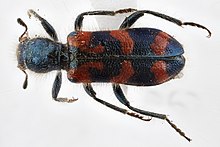| Trichodes ornatus | |
|---|---|
 | |
| Trichodes ornatus on October 16, 2012 in Wyoming | |
| Scientific classification | |
| Domain: | Eukaryota |
| Kingdom: | Animalia |
| Phylum: | Arthropoda |
| Class: | Insecta |
| Order: | Coleoptera |
| Suborder: | Polyphaga |
| Infraorder: | Cucujiformia |
| Family: | Cleridae |
| Genus: | Trichodes |
| Species: | T. ornatus |
| Binomial name | |
| Trichodes ornatus Say, 1823 | |
Trichodes ornatus, commonly known as ornate checkered beetle, is a beetle species of checkered beetles belonging to the family Cleridae, subfamily Clerinae which can be found only in North America. [1]